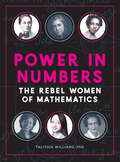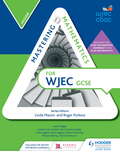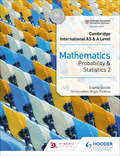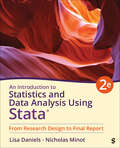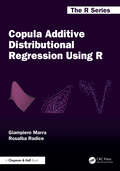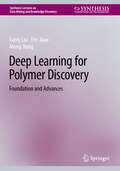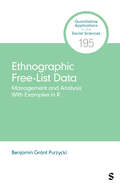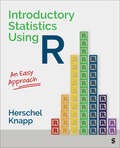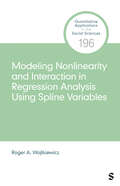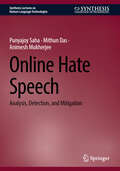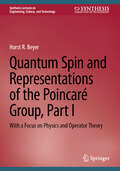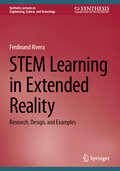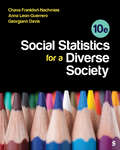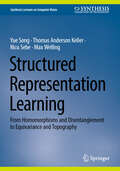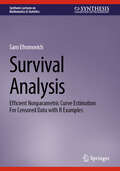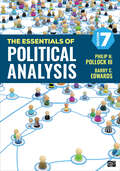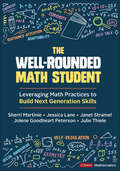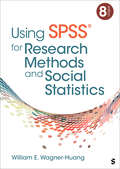- Table View
- List View
Power in Numbers: The Rebel Women of Mathematics
by Talithia WilliamsFrom rocket scientists to code breakers, “fascinating stories” of women who overcame obstacles, shattered stereotypes, and pursued their passion for math (Notices of the American Mathematical Society).With more than 200 photos and original interviews with several of the amazing women covered, Power in Numbers: The Rebel Women of Mathematics is a full-color volume that puts a spotlight on the influence of women on the development of mathematics over the last two millennia. Each biography reveals the life of a different female mathematician, from her childhood and early influences to the challenges she faced and the great achievements she made in spite of them. Learn how:After her father terminated her math lessons, Sofia Kovalevskaya snuck algebra books into her bed to read at nightEmmy Noether became an invaluable resource to Albert Einstein while she was in the NavyNative American rocket scientist Mary Golda Ross developed designs for fighter jets and missiles in a top-secret unitKatherine Johnson’s life-or-death calculations at NASA meant that astronauts such as Alan Shepard and John Glenn made it home aliveShakuntala Devi multiplied massive numbers in her head so her family could eat at nightPamela Harris proved her school counselors wrong when they told her she would only succeed as a bilinguial secretaryCarla Cotwright-Williams began her life in the dangerous streets of South-Central Los Angeles before skyrocketing to a powerful career with the Department of Defense in Washington, DCThese women are a diverse group, but their stories have one thing in common: At some point on their journeys, someone believed in them—and made them think the impossible was perhaps not so impossible.“A quick read . . . full of dramatic stories and eye-catching illustrations.” —MAA Reviews“I found myself marveling at the personal anecdotes and quotes throughout the book.” —Notices of the American Mathematical Society
Mastering Mathematics for WJEC GCSE: Higher
by Heather Davis Sophie Goldie Linda Liggett Gareth Cole Keith Pledger Rob Summerson Robin Liggett Richard PerringExam Board: WJECLevel: GCSESubject: MathematicsFirst Teaching: September 2015First Exam: June 2017Help students get to grips with the new style examinations in Numeracy and Mathematics with books that build all the necessary skills to progress their learning and develop their problem-solving skills.- Provides one book for each tier ensuring full coverage, with mathematics only questions and chapters clearly highlighted so the specifications can be co-taught or taught separately as required- Organises topics into units so as to provide questions that build understanding and fluency enabling students to confidently tackle and solve real and interesting problems- Enables students to identify the appropriate remediation or extension steps they need in order to make the best progress, through easy to follow progression strands that help to identify gaps in learning- Offers a seamless five year progression when used in conjunction with KS3 MasteringMathematicsWelsh editions will be available in Summer 2016
Cambridge International AS & A Level Mathematics Probability & Statistics 2
by Sophie GoldieExam board: Cambridge Assessment International EducationLevel: A-levelSubject: MathematicsFirst teaching: September 2018First exams: Summer 2020Endorsed by Cambridge Assessment International Education to provide full support for Paper 6 of the syllabus for examination from 2020.Take mathematical understanding to the next level with this accessible series, written by experienced authors, examiners and teachers.- Improve confidence as a mathematician with clear explanations, worked examples, diverse activities and engaging discussion points. - Advance problem-solving, interpretation and communication skills through a wealth of questions that promote higher-order thinking. - Prepare for further study or life beyond the classroom by applying mathematics to other subjects and modelling real-world situations.- Reinforce learning with opportunities for digital practice via links to the Mathematics in Education and Industry's (MEI) Integral platform in the eTextbooks.**To have full access to the eTextbooks and Integral resources you must be subscribed to both Dynamic Learning and Integral. To trial our eTextbooks and/or subscribe to Dynamic Learning, visit: www.hoddereducation.co.uk/dynamic-learning; to view samples of the Integral resources and/or subscribe to Integral, visit integralmaths.org/internationalPlease note that the Integral resources have not been through the Cambridge International endorsement process. This book covers the syllabus content for Probability and Statistics 2, including the Poisson distribution, linear combinations of random variables, continuous random variables, sampling and estimation and hypothesis tests. Available in this series:Five textbooks fully covering the latest Cambridge International AS & A Level Mathematics syllabus (9709) are accompanied by a Workbook, and Student and Whiteboard eTextbooks.Pure Mathematics 1: Student Textbook (ISBN 9781510421721), Student eTextbook (ISBN 9781510420762), Whiteboard eTextbook (ISBN 9781510420779), Workbook (ISBN 9781510421844)Pure Mathematics 2 and 3: Student Textbook (ISBN 9781510421738), Student eTextbook (ISBN 9781510420854), Whiteboard eTextbook (ISBN 9781510420878), Workbook (ISBN 9781510421851)Mechanics: Student Textbook (ISBN 9781510421745), Student eTextbook (ISBN 9781510420953), Whiteboard eTextbook (ISBN 9781510420977), Workbook (ISBN 9781510421837)Probability & Statistics 1: Student Textbook (ISBN 9781510421752), Student eTextbook (ISBN 9781510421066), Whiteboard eTextbook (ISBN 9781510421097), Workbook (ISBN 9781510421875)Probability & Statistics 2: Student Textbook (ISBN 9781510421776), Student eTextbook (ISBN 9781510421158), Whiteboard eTextbook (ISBN 9781510421165), Workbook (9781510421882)
An Introduction to Statistics and Data Analysis Using Stata®: From Research Design to Final Report
by Lisa Daniels Nicholas W. MinotAn Introduction to Statistics and Data Analysis Using Stata®: From Research Design to Final Report, Second Edition provides an integrated approach to research methods, statistics and data analysis, and interpretation of results in Stata. Drawing on their combined 25 years of experience teaching statistics and research methods, authors Lisa Daniels and Nicholas Minot frame data analysis within the research process—identifying gaps in the literature, examining the theory, developing research questions, designing a questionnaire or using secondary data, analyzing the data, and writing a research paper—so readers better understand the context of data analysis. Throughout, the text focuses on documenting and communicating results so students can produce a finished report or article by the end of their courses. The Second Edition has been thoroughly updated with all new articles and data—including coverage of ChatGPT, COVID-19 policies, and SAT scores—to demonstrate the relevance of data analysis for students. A new chapter on advanced methods in regression analysis allows instructors to better feature these important techniques. Stata code has been updated to the latest version, and new exercises throughout offer more chances for practice.
An Introduction to Statistics and Data Analysis Using Stata®: From Research Design to Final Report
by Lisa Daniels Nicholas W. MinotAn Introduction to Statistics and Data Analysis Using Stata®: From Research Design to Final Report, Second Edition provides an integrated approach to research methods, statistics and data analysis, and interpretation of results in Stata. Drawing on their combined 25 years of experience teaching statistics and research methods, authors Lisa Daniels and Nicholas Minot frame data analysis within the research process—identifying gaps in the literature, examining the theory, developing research questions, designing a questionnaire or using secondary data, analyzing the data, and writing a research paper—so readers better understand the context of data analysis. Throughout, the text focuses on documenting and communicating results so students can produce a finished report or article by the end of their courses. The Second Edition has been thoroughly updated with all new articles and data—including coverage of ChatGPT, COVID-19 policies, and SAT scores—to demonstrate the relevance of data analysis for students. A new chapter on advanced methods in regression analysis allows instructors to better feature these important techniques. Stata code has been updated to the latest version, and new exercises throughout offer more chances for practice.
Copula Additive Distributional Regression Using R (Chapman & Hall/CRC The R Series)
by Giampiero Marra Rosalba RadiceCopula additive distributional regression enables the joint modeling of multiple outcomes, an essential aspect of many real-world research problems. This book provides an accessible overview of this modeling approach, with a particular focus on its implementation in the GJRM R package, developed by the authors. The emphasis is on bivariate responses with empirical illustrations drawn from diverse fields such as health and medicine, epidemiology, economics and social sciences.Key Features: Provides a comprehensive overview of joint regression modeling for multiple outcomes, with a focus on bivariate responses Offers a practical approach with real-world examples from various fields Demonstrates the implementation of all the discussed models using the GJRM package in R Includes supplementary resources such as data accessible through the GJRM.data package in R and additional code available on the authors' webpages This book is designed for graduate students, researchers, practitioners and analysts who are interested in using copula additive distributional regression for the joint modeling of bivariate outcomes. The methodology is accessible to readers with a basic understanding of core statistics and probability, regression, copula modeling and R.
Deep Learning for Polymer Discovery: Foundation and Advances (Synthesis Lectures on Data Mining and Knowledge Discovery)
by Gang Liu Meng Jiang Eric InaeThis book presents a comprehensive range of topics in deep learning for polymer discovery, from fundamental concepts to advanced methodologies. These topics are crucial as they address critical challenges in polymer science and engineering. With a growing demand for new materials with specific properties, traditional experimental methods for polymer discovery are becoming increasingly time-consuming and costly. Deep learning offers a promising solution by enabling rapid screening of potential polymers and accelerating the design process. The authors begin with essential knowledge on polymer data representations and neural network architectures, then progress to deep learning frameworks for property prediction and inverse polymer design. The book then explores both sequence-based and graph-based approaches, covering various neural network types including LSTMs, GRUs, GCNs, and GINs. Advanced topics include interpretable graph deep learning with environment-based augmentation, semi-supervised techniques for addressing label imbalance, and data-centric transfer learning using diffusion models. The book aims to solve key problems in polymer discovery, including accurate property prediction, efficient design of polymers with desired characteristics, model interpretability, handling imbalanced and limited labeled data, and leveraging unlabeled data to improve prediction accuracy.
Ethnographic Free-List Data: Management and Analysis With Examples in R (Quantitative Applications in the Social Sciences)
by Benjamin Grant PurzyckiEthnographic Free-List Data: Management and Analysis With Examples in R details a method that involves research participants listing what they know or think about the researcher’s topic of interest. While researchers typically report these free-list analyses in isolation, this book incorporates them with other analytical methods and demonstrates how ethnographic free-lists can be useful to a broad social science audience. The first half of the book covers descriptive methods, and the second half incorporates insights from the early chapters into a predictive statistical framework. Author Benjamin Grant Purzycki explains how to collect, clean, and manage free-list data and how to use R to calculate and visualize the data.
Ethnographic Free-List Data: Management and Analysis With Examples in R (Quantitative Applications in the Social Sciences)
by Benjamin Grant PurzyckiEthnographic Free-List Data: Management and Analysis With Examples in R details a method that involves research participants listing what they know or think about the researcher’s topic of interest. While researchers typically report these free-list analyses in isolation, this book incorporates them with other analytical methods and demonstrates how ethnographic free-lists can be useful to a broad social science audience. The first half of the book covers descriptive methods, and the second half incorporates insights from the early chapters into a predictive statistical framework. Author Benjamin Grant Purzycki explains how to collect, clean, and manage free-list data and how to use R to calculate and visualize the data.
Introductory Statistics Using R: An Easy Approach
by Herschel KnappFinally, a textbook that makes it simple to teach and learn introductory statistics using the R software! Herschel Knapp′s Introductory Statistics Using R: An Easy Approach is a jargon-free guide to real-world statistics designed to concisely answer three important questions: Which statistic should I use? How do I run the analysis? How do I document the results? Practical examples presented throughout the text with exercises at the end of each chapter build proficiency through hands-on learning. The student website includes datasets, prepared R code for each statistic in the R Syntax Guide, and tutorial videos. As well as learning statistics, with this text students learn how to convert numeric results into clear, publishable documentation.
Introductory Statistics Using R: An Easy Approach
by Herschel KnappFinally, a textbook that makes it simple to teach and learn introductory statistics using the R software! Herschel Knapp′s Introductory Statistics Using R: An Easy Approach is a jargon-free guide to real-world statistics designed to concisely answer three important questions: Which statistic should I use? How do I run the analysis? How do I document the results? Practical examples presented throughout the text with exercises at the end of each chapter build proficiency through hands-on learning. The student website includes datasets, prepared R code for each statistic in the R Syntax Guide, and tutorial videos. As well as learning statistics, with this text students learn how to convert numeric results into clear, publishable documentation.
Modeling Nonlinearity and Interaction in Regression Analysis Using Spline Variables (Quantitative Applications in the Social Sciences)
by Roger A. Wojtkiewicz"Spline variables and their interactions play a crucial role in the field of social science. This book offers a comprehensive and detailed exploration of this method, providing valuable insights and information for researchers in the field." --Man-Kit Lei, The University of Georgia This volume addresses the issue of linear constraints in regression modeling. Author Roger A. Wojtkiewicz uses the method of knotted spline variables (also known as piecewise linear regression) and a new method involving group spline variables to model nonlinearity in a variety of situations. Using spline variables to model nonlinearity allows researchers to specify unrestricted models for models that involve interval variables, allowing for greater flexibility in modeling any possible interaction.
Modeling Nonlinearity and Interaction in Regression Analysis Using Spline Variables (Quantitative Applications in the Social Sciences)
by Roger A. Wojtkiewicz"Spline variables and their interactions play a crucial role in the field of social science. This book offers a comprehensive and detailed exploration of this method, providing valuable insights and information for researchers in the field." --Man-Kit Lei, The University of Georgia This volume addresses the issue of linear constraints in regression modeling. Author Roger A. Wojtkiewicz uses the method of knotted spline variables (also known as piecewise linear regression) and a new method involving group spline variables to model nonlinearity in a variety of situations. Using spline variables to model nonlinearity allows researchers to specify unrestricted models for models that involve interval variables, allowing for greater flexibility in modeling any possible interaction.
Online Hate Speech: Analysis, Detection, and Mitigation (Synthesis Lectures on Human Language Technologies)
by Animesh Mukherjee Punyajoy Saha Mithun DasThis book informs readers on how to understand, detect, and mitigate hate speech in online social media. The authors first cover the definition of hate speech and how its prevalence can be measured on online social media platforms using text and graph-based methods. The book then describes the process of detecting hate speech and presents a comprehensive account of the AI models that are currently being used. Further, the authors discuss the associated challenges that must be overcome while using these models. The book concludes with an overview of the mitigation techniques for hate speech, including blocking or suspension of the accounts (hard technique) and counterspeech (soft technique), and a discussion of the effects of these techniques on social media platforms.
Quantum Spin and Representations of the Poincaré Group, Part I: With a Focus on Physics and Operator Theory (Synthesis Lectures on Engineering, Science, and Technology)
by Horst R. BeyerThis book discusses how relativistic quantum field theories must transform under strongly continuous unitary representations of the Poincaré group. The focus is on the construction of the representations that provide the basis for the formulation of current relativistic quantum field theories of scalar fields, the Dirac field, and the electromagnetic field. Such construction is tied to the use of the methods of operator theory that also provide the basis for the formulation of quantum mechanics, up to the interpretation of the measurement process. In addition, since representation spaces of primary interest in quantum theory are infinite dimensional, the use of these methods is essential. Consequently, the book also calculates the generators of relevant strongly continuous one-parameter groups that are associated with the representations and, where appropriate, the corresponding spectrum. Part I of Quantum Spin and Representations of the Poincaré Group specifically addresses: conventions; basic properties of SO(2) and SO(3); construction of a double cover of SO(3); SU(2) spinors; continuous unitary representation of SU(2); basic properties of the Lorentz Group; unitary representation of the restricted Lorentz Group; an extension to a strongly continuous representation of the restricted Poincaré Group; and an extension to a unitary/anti-unitary representation of the Poincaré Group.
STEM Learning in Extended Reality: Research, Design, and Examples (Synthesis Lectures on Engineering, Science, and Technology)
by Ferdinand RiveraThis book synthesizes findings from recent and ongoing research on the use of Extended Reality (XR) to support learning of STEM content. XR is slowly being introduced in classrooms due to significant changes in XR technology. These tools were historically costly, unfriendly, and developed only for gamers. Today, XR tools are able to enhance students’ immersive experiences in such settings. In classrooms, in particular, they provide learners with an opportunity to manipulate abstract objects as if they are physical objects. The book begins with an extensive and detailed description and evaluation of the impact of various XR interventions on learning and engagement in STEM classrooms. The author then concludes with theoretical frameworks for investigating learning in computer- immersive contexts and practical implications for effectively using XR tools to learn STEM.
Social Statistics for a Diverse Society
by Anna Leon-Guerrero Georgiann Davis Chava Frankfort-NachmiasSocial Statistics for a Diverse Society introduces students to social statistics and their importance in the workplace, in the media, and in being able to conduct or interpret research. This bestselling book integrates statistical techniques with a wide range of social issues related to the dynamic interplay of race, class, gender, and other social variables: students become proficient in statistical techniques while learning about social differences and inequality through substantive examples and real-world data. The authors use straightforward language to explain statistical concepts and emphasize intuition, logic, and common sense over rote memorization and derivation of formulas. The Tenth Edition includes fresh topical examples and exercises, as well as new General Social Survey datasets with step-by-step SPSS and Excel video demonstrations.
Social Statistics for a Diverse Society
by Anna Leon-Guerrero Georgiann Davis Chava Frankfort-NachmiasSocial Statistics for a Diverse Society introduces students to social statistics and their importance in the workplace, in the media, and in being able to conduct or interpret research. This bestselling book integrates statistical techniques with a wide range of social issues related to the dynamic interplay of race, class, gender, and other social variables: students become proficient in statistical techniques while learning about social differences and inequality through substantive examples and real-world data. The authors use straightforward language to explain statistical concepts and emphasize intuition, logic, and common sense over rote memorization and derivation of formulas. The Tenth Edition includes fresh topical examples and exercises, as well as new General Social Survey datasets with step-by-step SPSS and Excel video demonstrations.
Structured Representation Learning: From Homomorphisms and Disentanglement to Equivariance and Topography (Synthesis Lectures on Computer Vision)
by Nicu Sebe Max Welling Yue Song Thomas Anderson KellerThis book introduces approaches to generalize the benefits of equivariant deep learning to a broader set of learned structures through learned homomorphisms. In the field of machine learning, the idea of incorporating knowledge of data symmetries into artificial neural networks is known as equivariant deep learning and has led to the development of cutting edge architectures for image and physical data processing. The power of these models originates from data-specific structures ingrained in them through careful engineering. To-date however, the ability for practitioners to build such a structure into models is limited to situations where the data must exactly obey specific mathematical symmetries. The authors discuss naturally inspired inductive biases, specifically those which may provide types of efficiency and generalization benefits through what are known as homomorphic representations, a new general type of structured representation inspired from techniques in physics and neuroscience. A review of some of the first attempts at building models with learned homomorphic representations are introduced. The authors demonstrate that these inductive biases improve the ability of models to represent natural transformations and ultimately pave the way to the future of efficient and effective artificial neural networks.
Survival Analysis: Efficient Nonparametric Curve Estimation For Censored Data with R Examples (Synthesis Lectures on Mathematics & Statistics)
by Sam EfromovichThis textbook provides a unified account of estimating the survival function, hazard rate, cumulative hazard, density, regression, conditional distributions, and linear functionals for the current status censored and right-censored data. The book contains the theory and methodology of efficient estimation, adaptation, dimension reduction, and confidence bands as well as the universal E-estimator for small samples. Exercises and a large number of simulated and real-life examples that can be repeated and modified using the complementary R package are also included. This coverage, together with the intuitive style of presentation, is ideal for people entering this field. The context is suitable for self-study or a one-semester course for graduate students with majors ranging from biostatistics and data analytics to econometrics and actuarial science.
The Essentials of Political Analysis
by Philip H. Pollock Barry Clayton EdwardsEquip students with the skills and confidence they need to conduct political analyses and critically assess statistical research. In the Seventh Edition of The Essentials of Political Science, bestselling authors Philip H. Pollock III and Barry C. Edwards build students’ analytic abilities and develop their statistical reasoning with new data, fresh exercises, and clear examples. This brief and reader-friendly guide walks students through the essentials— defining measurement, formulating and testing hypotheses, measuring variables—while using key terms, chapter-opening objectives, over 80 tables and figures, and practical exercises to get them using and applying their new skills. Using Excel, R, SPSS, or STATA? Companion workbooks featuring statistical software instructions and exercises help your students apply their knowledge.
The Essentials of Political Analysis
by Philip H. Pollock Barry Clayton EdwardsEquip students with the skills and confidence they need to conduct political analyses and critically assess statistical research. In the Seventh Edition of The Essentials of Political Science, bestselling authors Philip H. Pollock III and Barry C. Edwards build students’ analytic abilities and develop their statistical reasoning with new data, fresh exercises, and clear examples. This brief and reader-friendly guide walks students through the essentials— defining measurement, formulating and testing hypotheses, measuring variables—while using key terms, chapter-opening objectives, over 80 tables and figures, and practical exercises to get them using and applying their new skills. Using Excel, R, SPSS, or STATA? Companion workbooks featuring statistical software instructions and exercises help your students apply their knowledge.
The Well-Rounded Math Student: Leveraging Math Practices to Build Next Generation Skills
by Sherri L. Martinie Jessica Lane Janet Stramel Jolene Goodheart Peterson Julie ThieleIntegrate a holistic approach to mathematics success with essential personal and social skills Teaching math is more than just numbers. It’s about shaping future-ready students who are not only academically strong but thrive socially and emotionally. Research shows that learning both intrapersonal and interpersonal skills helps students academically, and teachers play a crucial role in providing social-emotional support. The Well-Rounded Math Student helps mathematics teachers in Grades K-12 foster both their students′ academic prowess and their social and emotional development. Through the lens of the Standards for Mathematical Practice, the book emphasizes the importance of intentionally teaching and promoting intrapersonal and interpersonal skills, or "Next Generation" skills, alongside mathematical concepts. The authors provide step-by-step guidance on how small adjustments in lesson planning can have a profound impact on students′ growth. Providing teachers with a new lens to leverage in their planning as well as concrete ways to use their mathematics lessons to explicitly teach and reinforce social and emotional competencies, this book: Holds a strengths-based mindset and approach—for both teachers and students Highlights the importance of the science and the art of teaching to enhance social development, human connection, classroom management, and community within classrooms Stresses that the overarching goal of education is to help students become responsible adults who are ready for their future Includes a lesson planning guide, competency builder activities, vignettes of enhanced lessons across grade bands, reflection questions, and suggestions for taking action The Well-Rounded Math Student bridges critical intrapersonal and interpersonal elements to help educators create an environment where students excel in math and develop the life skills they’ll carry forever.
The Well-Rounded Math Student: Leveraging Math Practices to Build Next Generation Skills
by Sherri L. Martinie Jessica Lane Janet Stramel Jolene Goodheart Peterson Julie ThieleIntegrate a holistic approach to mathematics success with essential personal and social skills Teaching math is more than just numbers. It’s about shaping future-ready students who are not only academically strong but thrive socially and emotionally. Research shows that learning both intrapersonal and interpersonal skills helps students academically, and teachers play a crucial role in providing social-emotional support. The Well-Rounded Math Student helps mathematics teachers in Grades K-12 foster both their students′ academic prowess and their social and emotional development. Through the lens of the Standards for Mathematical Practice, the book emphasizes the importance of intentionally teaching and promoting intrapersonal and interpersonal skills, or "Next Generation" skills, alongside mathematical concepts. The authors provide step-by-step guidance on how small adjustments in lesson planning can have a profound impact on students′ growth. Providing teachers with a new lens to leverage in their planning as well as concrete ways to use their mathematics lessons to explicitly teach and reinforce social and emotional competencies, this book: Holds a strengths-based mindset and approach—for both teachers and students Highlights the importance of the science and the art of teaching to enhance social development, human connection, classroom management, and community within classrooms Stresses that the overarching goal of education is to help students become responsible adults who are ready for their future Includes a lesson planning guide, competency builder activities, vignettes of enhanced lessons across grade bands, reflection questions, and suggestions for taking action The Well-Rounded Math Student bridges critical intrapersonal and interpersonal elements to help educators create an environment where students excel in math and develop the life skills they’ll carry forever.
Using SPSS® for Research Methods and Social Statistics
by William E. Wagner-HuangThis is the perfect companion for students who are learning to use the SPSS software to interpret and manage data. Students will appreciate author William E. Wagner-Huang’s step-by-step explanations of SPSS operating procedures and introductory statistical operations. The Eighth Edition uses version 29 of the software and incorporates results from the 2022 General Social Survey (GSS) as a dataset used in examples throughout the book. In response to user feedback, the author has expanded the sections on ANOVA and chi-square. The GSS datasets and codebooks for use with the text are available on an accompanying website.
